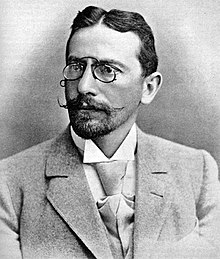
The Tarrasch rule is a general principle that applies in the majority of chess middlegames and endgames. Siegbert Tarrasch (1862–1934) stated the "rule" that rooks should be placed behind passed pawns – either the player's or the opponent's. The idea behind the guideline is that (1) if a player's rook is behind their own passed pawn, the rook protects it as it advances, and (2) if it is behind an opponent's passed pawn, the pawn cannot advance unless it is protected along its way.
The original quote came from his famous book about the St. Petersburg 1914 chess tournament, which was translated into English in 1993:
- The rooks belong behind passed pawns, behind their own in order to support their advance, behind the enemy's in order to impede their advance.[1]
He referred to his rule 24 years later on page 57 of his book The Game of Chess (1938) as:
- In complicated Rook endings the most important rule is one laid down by the author: The Rook's place is behind the passed pawn; behind the enemy pawn in order to hold it up, behind one's own in order to support its advance.[2]
This "rule" is usually true, but not always, as there are many exceptions. Tarrasch has been quoted as saying, "Always put the rook behind the pawn... Except when it is incorrect to do so."[3]
- ^ Tarrasch, St Petersburg 1914: International Chess Tournament, translated by Dr Robert Maxham, Caissa Editions, Yorklyn, DE, 1993, ISBN 0-939433-17-6—comment on Frank James Marshall vs Emanuel Lasker, St. Petersburg (1914), rd 3, Apr-24, p. 83, emphasis in original.
- ^ Book source
- ^ (Soltis 2003:129)